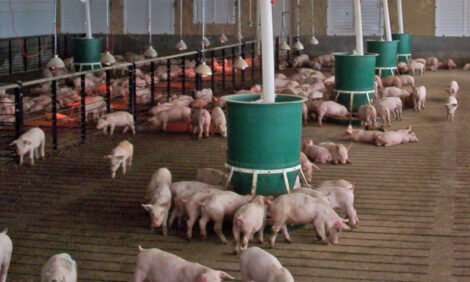



Matching Product Performance to Market Needs
By Dr Alan E Tinch, Head of Genetics and R&D, JSR Genetics Ltd - This is a report from The 14th Annual JSR Technical Conference held on the 16th September 2003. The function of our industry is to produce pork for the consumer which is wholesome and desirable at an affordable price. The price should allow all sectors of the market to make reasonable profits.The Industry
The consumer is king, or more correctly, queen and we must have a very good understanding of what he or she needs, expects and values from pork.
The role of the breeder is to develop and produce breeds which satisfy the needs of the consumer and which work effectively and efficiently within the production chain. Genetic progress proceeds as a series of small steps so the breeder must also understand future requirements to develop products which will be of value in 5 to 10 years’ time.
The UK market in particular has recently faced difficult times. There have been, and are, serious problems with disease. Low prices have been experienced over an extended period and unfavourable exchange rates have drawn in cheaper pork from abroad. As a result the market has contracted. However, it should be remembered that all markets will face this type of pressure. A clear understanding of the needs and expectations of the consumer is fundamental producing a desirable product to succeed in difficult market conditions.
Forces affecting the Industry
In simple terms, the production chain consists of breeders which sell breeds to farmers who multiply and grow pigs. These pigs are sold to processors who supply meat to retailers for sale to the consumer. Each of the stakeholders has different requirements from the animal.
The farmer is generally concerned with the cost of producing the pig either as a weaner or finished slaughter pig. His costs are a balance between the level of performance achieved (i.e. number of pigs per sow per year, growth rate, feed efficiency etc) and the amount of input required (i.e. feed, labour vaccinations, depreciation etc). Any factor which changes performance or input required will affect cost of production. In the current UK and European market there is major concern over the effect of disease on performance. Any change which increases the robustness of the animal and reduce the impact of disease would be welcome. Changes to production systems driven by legislation and based on perceived consumer values will continue to increase costs. An ongoing challenge to the European farmer will be the availability of labour. This will require increasing amounts of automation and breeds that are “easy to manage”.
The processor is mainly concerned with the value of the pig to his operation as opposed to the cost of producing a pig. In a non-integrated production system this can lead to tension between the farmer and the processor. The value of the pig is measured in terms of meat yield (low back fat) and quality. Changes to carcase grading systems which support increased meat yield rather than penalising fat levels may change the breed requirements and nutritional strategy. Quality in this situation is the suitability of the meat or carcase for the production system.
The retailer and consumer have similar needs and expectations from the product. The retailer increasingly acts as the guardian of the value and quality of pork for the consumer. Value of the product is measured in terms of price, convenience and quality. Quality to the consumer is assessed as eating quality and increasingly as ease of preparation and lack of waste.
Quality
Quality is a well-used term in the industry. A broad definition of quality is “fitness for purpose”. This can be measured as the ability of the product to do what is supposed to do. In applying quality assessment to each aspect of the industry we should ask does the product do what it is supposed to do.
Market Sectors
The pig industry can be divided up into different market sectors with differing requirements (Fig 1).

If the two principal aspects of production are examined – cost of producing a slaughter pig and cost of producing a weaner then four market sectors can be identified.
The Standard/General Purpose market is the biggest market sector. This sector is concerned with producing high lean meat percentage at lowest cost. Reducing cost and improving performance has driven this sector to intensive production systems and this sector will always be predominant when low cost meat is required.
Consumer pressure against intensive breeding systems has led to the development of an Alternative Production System sector. Semi intensive and extensive/outdoor systems increase the cost of producing weaners but as long as the consumer is prepared to pay higher prices then this market will exist. Pigs suitable for this sector need to be robust have good mothering ability and be easy to manage.
The desire for improved eating quality of pork has led to the development of an Enhanced Meat Quality sector. Meat quality can be altered by diet and changes to processing systems. Alternative breed such as Duroc and Hampshire can also be incorporated as sire lines to enhance meat quality. However, all of these changes result in increased cost of producing a slaughter pig. The market sector will continue to exist as long as consumers are prepared to bear the cost.
A Premium market sector can be identified where Alternative Production Systems are combined with Enhanced Meat Quality options. Organic production systems are a good example of this. However the high costs incurred in these systems severely limit the size of this market sector.
In the current market environment there is much discussion of the requirements of the higher cost sectors. However the majority of pork consumed will derive from the Standard/General Purpose sector. Within this sector the main aims are to maximise profit by reducing the cost of production (number born, growth rate, feed efficiency and reduced mortality) and increasing carcase value (meat yield, back fat and meat quality). This will continue to be the main focus of the breeding programme.
Products to Match Market Needs
JSR Genetics has a range of product to meet these market needs:
-
The Genepacker 90 is the dam line aimed at the Standard General Purpose market sector. In combination with alternative sire lines can also be used to produce slaughter pigs with enhanced meat quality. The Gold X and Genepacker 120 are aimed at the semi intensive and extensive production sectors. Inclusion of Duroc genes in these breeds gives increased robustness and improved meat quality.
-
The standard sire lines are designed to meet the needs of the Standard/General Purpose producer although when mated with Gold X or Genepacker 120 can also meet the needs of the Alternative Production Sector. The Yorker and 2006 are fast growing and have excellent meat yield. The Yorker is derived from conventional white lines and the 2006 incorporates some Pietrain genetics to improve conformation. The Titan is a Pietrain type sire and offers advantages in meat yield and killing out percentage.
-
The needs of the Enhanced Meat Quality sector will be met by a range of speciality sire lines such as Duroc or Hampshire which will continue to be developed and maintained by JSR Genetics.
How do we get a closer fit?
The JSR breeding programme is designed to give genetic progress to improve the performance of these products in their relevant market sectors. However the analysis of the changing market needs above suggests we will need to address issues such as robustness, ease of management and product quality. These traits are obviously important but the definitions are vague and breeding programmes depend on precise and defined measurements to work effectively. A number of functional traits can be defined which can be used for selection.
Functional Traits
Output of 7kg piglets weaned
This trait combines the number and quality of piglets with mothering ability and can be addressed by an index of the component traits using conventional genetics. Such an approach gets around the potential conflict of litter size and birth weight seen in some hyper-prolific lines.
Post-weaning growth and appetite
It is becoming increasingly obvious that good rearing and growing performance is dependent on the ability of the weaned pig to overcome the trauma of weaning. Robust piglets will make the transition from milk to solid feed with a small check in growth. By measuring and selecting for growth rate in the early post weaning period using conventional genetics the robustness and uniformity of the pig will be improved.
Leg strength
Good performance depends on the pig having strong, straight legs. Improvement of leg strength will continue by using family incidence of defined leg problems.
Disease resistance
Selection for disease resistance is difficult under high health conditions. A large amount of research effort has been aimed at identifying disease resistance genes and some genes which are claimed to improve resistance to specific pathogens have been identified. However, since the immune system depends on having extensive variation to counteract the vast range or potential pathogens it is perhaps naive to try to identify disease resistance genes for every possible disease. A more fruitful approach is to look for innate components of the immune system which are capable of reacting quickly and effectively against pathogens.
Meat yield
The pig industry has been very effective at reducing fat levels to improve meat yield. Improvements in scanning systems and computerised image analysis combined with conventional genetics will enhance the selection for yield of high value meat cuts.
Getting a bigger hit
The last five years have seen a big increase in the amount of AI used. We are currently limited in the number of doses of semen we can obtain from single boars. If, however, the number of viable doses could be increased the utilisation of high merit boars would also increase. Techniques such as low dose insemination using deep intra-uterine catheters are being investigated to maximise the impact of genetic progress.
Genetics cannot make improvement in isolation. Improved genetics will depend on improved practice in nutrition, management and health. Ongoing success will depend on cooperation of Geneticists, Nutritionists, Veterinarians and Production Managers.
The Future
Breeding companies will be successful if they have vision for the future of the industry. Understanding of customer needs and expectation is fundamental to producing desirable products. Progress needs to be balanced with selection for a range of traits. Breeding companies need to work in partnership with producers and customers to develop breeds and management systems to improve product performance.
Source: JSR - 16th September 2003









